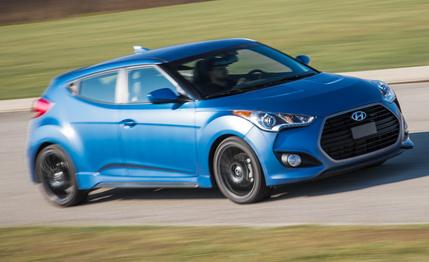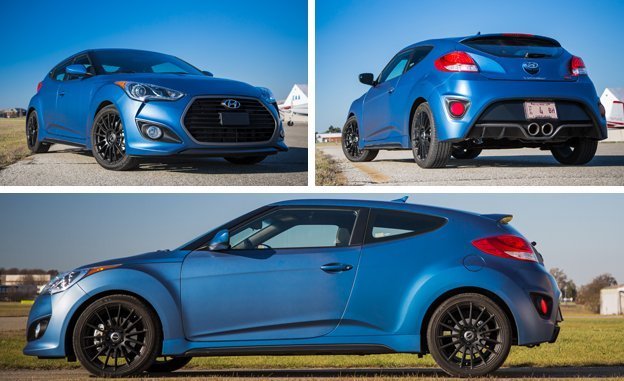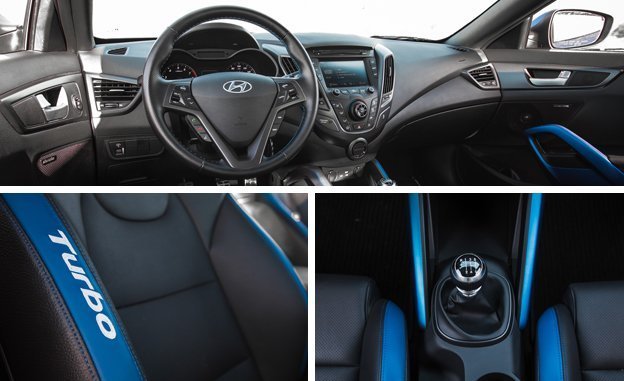 Instrumented Test
Instrumented Test
It has been three years since Hyundai added the turbocharged version of the Veloster hatchback and four since the Veloster originally went on sale. Perhaps because of its bizarre, asymmetric door layout—a single large portal for the driver, two smaller apertures on the passenger side serving front and rear seats—the Veloster’s exterior styling still feels fresh. Now, late in the model’s life, Hyundai has taken the 201-hp Turbo and crafted the Rally Edition to mine its rally-racing participation for some added spice.
In this case, we’re tempted to describe the Rally Edition not as a stand-in for a high-performance rally car, but rather literally, as a rally car. As in, it’s a late-cycle special edition intended to rally buyers to the Veloster fold. Toward that end, the Rally Edition performs more than adequately. Goodies such as matte-blue paint, revised front and rear fascias, lightweight 18-inch Rays wheels, and carbon-fiber-esque trim can’t be found on other Velosters. (The standard B&M short-throw shifter kit for the six-speed manual transmission can be fitted to other Velosters.) The Rally Edition also features a revised suspension with stiffer springs, dampers, and anti-roll bars.

Hyundai also took care to position the Rally Edition within spitting distance of the rest of the Veloster lineup. Based on the Turbo R-Spec, the least-expensive turbocharged Veloster, the Rally Edition is $2350 dearer. Curiously, the Rally Edition is also pricier than the stick-shift Veloster Turbo, by $1350, but goes without that model’s leather seat upholstery, heated front chairs, push-button ignition, and electroluminescent gauge cluster. The Rally Edition does come with the Turbo’s eight-speaker, 450-watt Dimension audio system, however, as well as a special blue-and-black interior color scheme, Rally Edition floor mats, and a Rally Edition badge.
Although it has the same 201-hp 1.6-liter turbocharged four-cylinder engine as other Veloster Turbos, the Rally Edition performed better than the last Veloster Turbos we tested. At 6.7 and 15.0 seconds, our recorded zero-to-60-mph and quarter-mile times beat the previous manual we tested by 0.6 second to 60 and by a half-second in the quarter-mile. It also was zippier than the automatic-equipped Veloster Turbo, by 0.1 second to 60 and by 0.4 second in the quarter-mile.
The sport suspension reins in body roll slightly compared to regular Veloster Turbos, but the biggest improvement actually is in ride quality. While certainly firmer, the stiffer springs and shocks work better in concert than the components on other Velosters. As with those cars, chassis flex is still an issue—the car’s platform is among the oldest in Hyundai’s current lineup, dating back to the previous-generation Elantra—and the steering is simply there, returning little feedback and a syrupy off-center behavior that isn’t very sporty. Push too hard, and the Rally Edition understeers dutifully until you back off.

Riding on a wider version of the same Kumho all-season tires standard on other Veloster Turbos, the Rally Edition posted a 0.85-g skidpad figure, right in between the 0.80 g we recorded in a Turbo with the slimmer rubber and the 0.90 g we got in a Turbo with optional summer tires (which, curiously, aren’t available on the Rally Edition). It’d be great if accessing the upper echelons of the Veloster’s handling potential didn’t require additional cash layout for higher-performance rubber, but at $24,950 as tested (including a $50 cargo net and $115 mud guards), there should be plenty of cash left in the budget for proper tires.
As with the standard Veloster Turbo, the Rally Edition is neither as good nor as expensive as Volkswagen’s GTI. It is, however, an entirely competent small car with punchy power and eye-catching looks. Sure, the interior is showing its age, the infotainment system appears dated alongside Hyundai’s latest, and road and wind noise are more intrusive than in newer compact cars. But the ergonomics are good and nothing inside feels outright cheap. So will the neat Rally Edition gear be enough to boost interest in the aging Veloster a little while longer? That’s as debatable as the Rally Edition’s tenuous connection to Hyundai’s actual rally-racing efforts, but it represents a decent rallying cry.